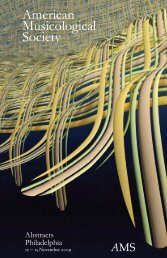Abstracts - American Musicological Society
Abstracts - American Musicological Society
Abstracts - American Musicological Society
Create successful ePaper yourself
Turn your PDF publications into a flip-book with our unique Google optimized e-Paper software.
Saturday morning<br />
BENEVENTO AND MILAN: RITEs AND MELoDIEs coMPARED<br />
Thomas Forrest Ke11y, Arnerican Academy in Rome<br />
The Beneventan chant of south .Ita1y has been<br />
recognized si.nce the pioneering studies of Dorn Hesbert<br />
half a century ago as the remnarrt of a liturgical<br />
practice that antedates the introduction of Gregorian<br />
Chant in the region, When the scribes of the surviving<br />
manuscripts refer to the local music, however, they<br />
invariably call it "Anbros ian. " And indeed, pope<br />
Stephen IX in 1058 specifically forbade the singing of<br />
"ambrosianus cantus" at Montecassino.<br />
Arnbrosian is, of cou!se, also the name for the<br />
rite of Milan, one of the ferr non-Gregorian chant<br />
repertories to survive the Carolingian urge to<br />
unifornity. And although these two bodies of chant are<br />
substantially independent, a thorough conparison shows<br />
that a nurnber of pieces share common texts and, in some<br />
cases, melodies.<br />
This paper details these sinilarities. Melodic<br />
comparisons shorr the nature of the musical relationship<br />
between the repertories and suggest that in many cases<br />
the Beneventan version of a chant represents a stage<br />
closer to a common original. The separate development<br />
from the joint repertory is connected with the fall of<br />
the northern kingdorn of the Lornbards in the eighth<br />
century and the subsequent continuation of Lombard<br />
tradition in the Beneventan South.<br />
FORMULAIC USAGE AMONG GREGORIAN INTROITS<br />
Theodore Karp, Northwestern University<br />
In the past Gregorian melodic constructions have<br />
ordinarily been classified according to a system with<br />
three categories: type melodies, centonized melodies,<br />
and free nelodies, As scholars have moved towards more<br />
precise descriptions of chant, the shortcomings of this<br />
system have becorne increasingly apparent. The need for<br />
a reappraisal of the term " centonization" has already<br />
been recognized by several. The term ufreeu melodies<br />
as applied to lntroits, Offertories, and Communions, is<br />
equally open to misconception and misuse. It tends to<br />
create the irnage of individualistic rnelodic<br />
constructions that avoid the stereotypical. Yet the<br />
forrnulaic character of Gregorian Introits has already<br />
been noted by scholars such as Thomas Connolly and<br />
Hendrik van der Werf. Study shows that these chants<br />
differ frorn the melisnatic genres prinarily in terms of<br />
the structural leve1 of formulaic usage and only<br />
secondarily in terms of the density of such use. At<br />
ptesent we do not have any account of the manner in<br />
r+hich formulae operate within this repertoire. This<br />
paper wil"l demonstrate the various principles of










